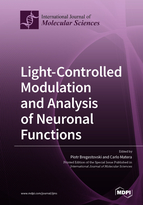Light-Controlled Modulation and Analysis of Neuronal Functions
A special issue of International Journal of Molecular Sciences (ISSN 1422-0067). This special issue belongs to the section "Molecular Biophysics".
Deadline for manuscript submissions: closed (31 July 2022) | Viewed by 35144
Special Issue Editors
2. Institute of Neurosciences, Kazan State Medical University, 420111 Kazan, Russia
3. Department of Normal Physiology, Kazan State Medical University, 420111 Kazan, Russia
Interests: cys-loop receptors; ion channels; synaptic transmission; genetically encoded biosensors; optopharmacology
Special Issues, Collections and Topics in MDPI journals
Interests: medicinal chemistry; chemical biology; photopharmacology; translational chemistry; GPCRs; biased signaling; ion channels; acetylcholine; muscarinic receptors; nicotinic receptors; dopamine; dopamine receptors; multi-target ligands; bifunctional ligands; dual-acting agents; dualsteric ligands; bitopic ligands; photoswitches; cancer; antibiotics; neurodegeneration
Special Issues, Collections and Topics in MDPI journals
Special Issue Information
Dear Colleagues,
Contemporary research has been enriched by new directions in which light plays a key role as a tool for the modulation of cellular activity and the invasive monitoring of intracellular ions and other components. The progress in molecular biology, imaging techniques and other modern technologies has led to the emergence of three main areas in which light is the main tool: optogenetics, photopharmacology and optosensorics. The main advantages of these approaches are the possibilities to investigate the functions of cells; modulate the activity of ion channels, synaptic transmission and neuronal circuits; measure concentrations of ions and other cellular components; and even control the behaviour of organisms.
Due to the development of these powerful molecular and genetic tools, our understanding of the mechanisms underlying the functioning of the nervous system has greatly advanced. This Special Issue is intended to highlight the latest experimental and methodological advances in these areas, as well as to present review articles with a primary focus on light-based analysis and control of neuronal functions. A discussion of the difficulties and limitations of using light as a modulator of cellular activity is also planned.
Prof. Dr. Piotr Bregestovski
Dr. Carlo Matera
Guest Editors
Manuscript Submission Information
Manuscripts should be submitted online at www.mdpi.com by registering and logging in to this website. Once you are registered, click here to go to the submission form. Manuscripts can be submitted until the deadline. All submissions that pass pre-check are peer-reviewed. Accepted papers will be published continuously in the journal (as soon as accepted) and will be listed together on the special issue website. Research articles, review articles as well as short communications are invited. For planned papers, a title and short abstract (about 100 words) can be sent to the Editorial Office for announcement on this website.
Submitted manuscripts should not have been published previously, nor be under consideration for publication elsewhere (except conference proceedings papers). All manuscripts are thoroughly refereed through a single-blind peer-review process. A guide for authors and other relevant information for submission of manuscripts is available on the Instructions for Authors page. International Journal of Molecular Sciences is an international peer-reviewed open access semimonthly journal published by MDPI.
Please visit the Instructions for Authors page before submitting a manuscript. There is an Article Processing Charge (APC) for publication in this open access journal. For details about the APC please see here. Submitted papers should be well formatted and use good English. Authors may use MDPI's English editing service prior to publication or during author revisions.
Keywords
- light-controlled molecular switches
- molecular engineering
- photopharmacology
- chemical optogenetics
- azo compounds
- optogenetics
- photochromic ligands
- biosensors
- genetically encoded biosensors
- synaptic transmission
- receptors
- ion channels
- light-activated channels
- light delivery
- light therapy
- transgenic mouse








